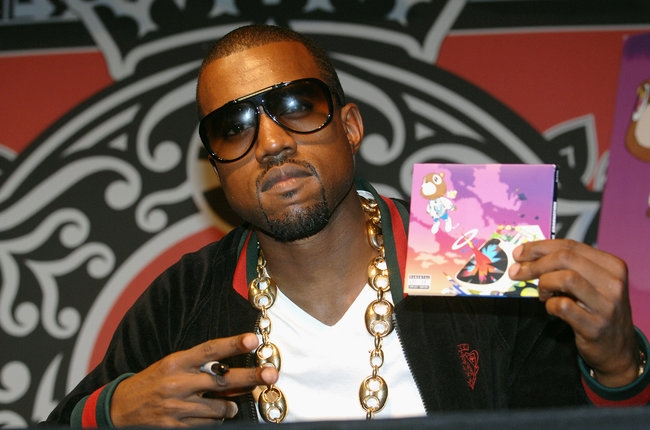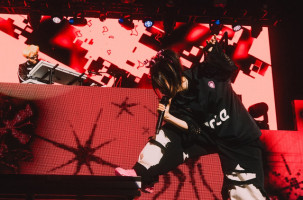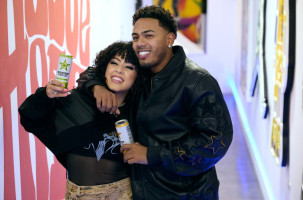Graduation era Kanye 
“I wanted to cross genres and show people how we could still express ourselves with something fresh, that’s what hip-hop’s all about. And momma, all I’m going to do is keep making you proud, we run this.”
Kanye West then proceeded to walk off stage with his statue for best rap album at the 2008 Grammys. After putting the sophomore slump narrative to rest with Late Registration, the Stanley Kubrick-inspired West craved a new mountain to conquer. During an era in which Nas claimed hip-hop was dead, Kanye helped rejuvenate the genre by injecting an electronic sound into hip-hop that was never before seen.
Coming off touring the world with U2, Kanye had newfound inspiration he would then pour into his next album. A war of words with 50 Cent also pushed his limits of creativity as the two rap stars put their careers on the line in a sales battle, which the loser was to retire from making music. The Chicago native took it upon himself to jump-start his legacy as a world-wide superstar.
This project would feature significantly fewer guest artists than suphomore effort Late Registration, but that album's co-producer Jon Brion would remain heavily involved in the creative direction as West -- who suffers from synesthesia -- began painting his masterpiece shortly after that LP's summer 2005 release. Kanye exuded his appreciation of design by calling on Japanese pop artist, Taskashi Murakami to create Graduation’s influential cover image.
On September 11th, 2007 West released his third education-themed project with Graduation. The futuristic 14-track set contained five singles, all of which charted on the Billboard Hot 100. West demolished Fifty in a landslide, outselling the Curtis artist 957,000 to 691,000 in first week album sales.
The Daft Punk-featuring, genre-mashing lead single “Stronger” soon sat atop the Hot 100, giving the then 30-year-old artist his third Hot 100 No. 1 hit on the chart dated September 29th, 2007 -- effectively breaking up Soulja Boy’s “Crank Dat” run. Sadly, Graduation would end up being the last album Kanye’s mother, Donda West, would hear before she passed less two months later, due to cosmetic surgery complications.
Anthony Kilhoffer, a four-time Grammy award winning engineer and producer, has been heavily involved in every Kanye West project, even prior to him signing with Roc-A-Fella. Billboard caught up with Kilhoffer in honor of the ten-year anniversary for a first-hand account of what may be go down as Ye’s best work. Kilhoffer gets in depth on the recording process at The Record Plant in Hollywood, how the project came together fairly quickly, Plain Pat’s doubt of the now 7x-platinum “Stronger,” and how Young Jeezy originally had a verse on “Can’t Tell Me Nothing" -- and much more.
Break out your shutter-shades and make sure to keep Graduation in heavy rotation in honor of its tenth birthday. Kanye’s visionary 54-minute classic is now multi-platinum, and still maintains as fresh and tuneful a sound as it did when we listened through our iPod headphones back in 2007.
What was your specific role for this project, and what tracks did you have a hand in mixing/producing?
Anthony Kilhoffer: I engineered most of the songs. I mixed a couple, and helped produce with Andy Chatterley on "Stronger," "Flashing Lights" and a few others. I was there from the beginning. It's all Jon Brion's collaborative effort, continuing along from Late Registration. I was in the studio every day with Kanye, as he was traveling the world picking up things from other producers to develop ideas. Then, he would come back to Los Angeles and finalize the raps.
Did Kanye use his beef with 50 Cent as inspiration in the studio?
Definitely. At the time Fifty was still huge. You always have to raise the bar, and that helped. Once the "sophomore slump" was put to rest, he had to have something to fight against. Every movie has a villain -- even in real life you have to challenge yourself.
What about previously touring with U2, do you believe that played a role in West spawning an electronic sound?
This was a time he was more international than ever, closing larger festivals across the world that made him think more than just American hip-hop. This was the beginning of the Kanye West international superstar legacy. "Gold Digger" also raised the bar, so he used five singles on this record -- hardly anyone has five singles on an album that can chart.
What can you recall about the recording process of "Stronger?"
When he sampled Daft Punk ["Harder Better Faster Stronger"] on an ASR-10 for "Stronger," Plain Pat said, ‘You can't flip this. It's not going to work.’ Pat was highly skeptical. At the end of the day, he cooked up "Stronger" in five minutes, and it was quite a departure from the boom-bap Kanye West production, and the beginning of experimenting with other albums. After he had the beat, I remember people poking their heads in the Record Plant studio and telling him it was fire.
Do 75 mixes of "Stronger" really exist?
Yes, of course. He probably had eight to ten different mixing engineers on the song. I'd say there's ten a piece to each mixer. I know I mixed that song for two weeks straight every da,y and that was after it had been mixed by five other engineers. Then we mixed it for another week, and Jon Brion suggested if we wanted a dirty sound, to run it all through the cassette deck and bust it back through the board. We were trying all different kinds of non-traditional methods to get to the final version.
He was taking it out of the studio and playing it in clubs to see how people would respond. It was also a different era in music, mixing on a desk, and it was the beginning of Pro Tools dominating in the studio. It was difficult finding where it was going to fit in, whether it was going to be hip-hop or electronic.
When did Timbaland get involved to make the drums pop?
Timbaland came in at the end and added finishing touches to the drums. It had been in a lot of different producers’ hands. It was the beginning of Kanye allowing other producers to have their hand in things to see what they could bring to the table. With such a great song like this, we had to make sure those drums were perfect.
Can you talk a little about how "Good Life" came together?
DJ Toomp started that beat. They had a collaboration and writing session in Atlanta. He thought it was fire. The beat is so good [that] it needed an impactful hook. With a track that hot, you couldn't just pick the first or second hook idea, he was seeking perfection again. You have to keep searching and going through artists and see what they can give over this kind of production to take it to another level. That's why there's so many different hooks. Right away you could tell when he played it for people [that] it was the one that got them off the couch and dancing in the studio.
“Can’t Tell Me Nothing” was already crafted early on as well, correct?
Young Jeezy actually had a verse on "Can't Tell Me Nothing," but the only thing Kanye ended up leaving in was the ad-libs. I think with that song title, it's Kanye's mantra. You can't have a feature on that track. “Can't Tell Me Nothing” actually materialized very quick [with] only a few writes. That was one of those when you heard and knew it was genius. “Wait til I get my money right,” that line to this day is everyone’s favorite. When we heard that, we knew it would be a success. It all materialized pretty early on in the process.
Getting into "Flashing Lights," what was the recording process like? I know you mixed on it as well.
It was an Eric Hudson beat that came in toward the very end of the process at Chalice studios. When we were mixing, he happened to be in the building and we played him some beats and Kanye liked it. The horn stabs and the hook was very R&B and “churchy.” I sent them to Andy Chatterley, an English producer who I had on "Stronger" and "Good Morning" -- he was way more electronic at the time. So we swapped out the horns for synthesizers to make it more aggressive to fit the "Stronger" mold.
How did Chris Martin get involved with “Homecoming?”
Chris Martin just showed up one day and recorded on the song. At that time, Kanye would travel around the world. Nowadays, people come to him when he records. In this era, he was going around and meeting other producers in Atlanta, New York, and London. Then he would come back with Jon Brion and post up at the Record Plant, then bring in John Legend and his team members like Mike Dean.
You mixed “The Glory,” what made that record special?
I think it was a beat for Common's album and he took it. Common was always trying to get him to focus on his projects. He was good to start the composing process, so Common's record got the creative ideas flowing and he would make a beat and if someone didn't like it he would put it to the side.
Are there any other tracks you remember something significant about?
On "Champion," I believe Kanye wrote a hand-written letter to get that sample cleared with Steely Dan. That was quite a feat to overcome. I think he used the fact it was a song about his father, and how he inspired him to be successful.
What do you think the legacy of Graduation is, looking back on ten years since its release?
I think it was the first time having a heavy hand in the use of electronic music in hip-hop. Previous to that it was very R&B influenced, tracks like "Stronger" and "Flashing Lights" contained very electronic type of elements. This was way before EDM became mainstream, and marked the end of the jersey-wearing era in hip-hop.












